-
Word stress, its acoustic
nature. -
The
linguistic function of a word stress. -
Degree
and position of a word stress.
-1-
The
sequence of syllables in the word is not pronounced identically. The
syllable or syllables which are pronounced with more prominence than
the other syllables of the word are said to be stressed or accented.
The correlation of varying prominences of syllables in a word is
understood as the accentual structure of the word.
According
to A.C. Gimson, the effect of prominence is achieved by any or all of
four factors: force, tone, length and vowel colour. The dynamic
stress implies greater force with which the syllable is pronounced.
In other words in the articulation of the stressed syllable greater
muscular energy is produced by the speaker. The European languages
such as English, German, French, Russian are believed to possess
predominantly dynamic word stress. In Scandinavian languages the word
stress is considered to be both dynamic and musical (e.g. in Swedish,
the word komma
(comma) is distinguished from the word komma
(come) by a difference in tones). The musical (tonic) word stress is
observed in Chinese, Japanese. It is effected by the variations of
the voice pitch in relation to neighbouring syllables. In Chinese the
sound sequence “chu” pronounced with the level tone means “pig”,
with the rising tone “bamboo”, and with the falling tone “to
live”.
It is fair
to mention that there is a terminological confusion in discussing the
nature of stress. According to D. Crystal, the terms “heaviness,
intensity, amplitude, prominence, emphasis, accent, stress” tend to
be used synonymously by most writers. The discrepancy in terminology
is largely due to the fact that there are 2 major views depending on
whether the productive or receptive aspects of stress are discussed.
The main
drawback with any theory of stress based on production of speech is
that it only gives a partial explanation of the phenomenon but does
not analyze it on the perceptive level.
Instrumental
investigations study the physical nature of word stress. On the
acoustic level the counterpart of force is the intensity of the
vibrations of the vocal cords of the speaker which is perceived by
the listener as loudness. Thus the greater energy with which the
speaker articulates the stressed syllable in the word is associated
by the listener with greater loudness. The acoustic counterparts of
voice pitch and length are frequency and duration respectively. The
nature of word stress in Russian seems to differ from that in
English. The quantitative component plays a greater role in Russian
accentual structure than in English word accent. In the Russian
language of full formation and full length in unstressed positions,
they are always reduced. Therefore the vowels of full length are
unmistakably perceived as stressed. In English the quantitative
component of word stress is not of primary importance because of the
non-reduced vowels in the unstressed syllables which sometimes occur
in English words (e.g. “transport”, “architect”).
-2-
In discussing accentual
structure of English words we should turn now to the functional
aspect of word stress. In language the word stress performs 3
functions:
-
constitutive– word
stress constitutes a word, it organizes the syllables of a word into
a language unit. A word does not exist without the word stress. Thus
the function is constitutive – sound continuum becomes a phrase
when it is divided into units organized by word stress into words. -
Word
stress enables a person to identify a succession of syllables as a
definite accentual pattern of a word. This function is known as
identificatory (or
recognitive). -
Word
stress alone is capable of differentiating the meaning of words or
their forms, thus performing its distinctive
function. The accentual patterns of
words or the degrees of word stress and their positions form
oppositions (“/import – im /port”, “/present – pre
/sent”).
-3-
There are
actually as many degrees of word stress in a word as there are
syllables. The British linguists usually distinguish three degrees of
stress in the word. The primary stress is the strongest (e.g.
exami/nation), the secondary stress is the second strongest one (e.g.
ex,ami/nation). All the other degrees are termed “weak stress”.
Unstressed syllables are supposed to have weak stress. The American
scholars, B. Bloch and J. Trager, find 4 contrastive degrees
of word stress: locid, reduced locid, medial and weak.
In
Germanic languages the word stress originally fell on the initial
syllable or the second syllable, the root syllable in the English
words with prefixes. This tendency was called recessive. Most English
words of Anglo-Saxon origin as well as the French borrowings are
subjected to this recessive tendency.
Languages
are also differentiated according to the placement of word stress.
The traditional classification of languages concerning the place of
stress in a word is into those with a
fixed stress and a free stress. In
languages with a fixed stress the occurrence of the word stress is
limited to a particular syllable in a multisyllabic word. For
example, in French the stress falls on the last syllable of the word
(if pronounced in isolation), in Finnish and Czech it is fixed on the
first syllable.
Some
borrowed words retain their stress.
In languages with a free
stress its place is not confined to a specific position in the word.
The free placement of stress is exemplified in the English and
Russian languages
(e.g. E. appetite – begin –
examination
R.
озеро – погода
– молоко)
The word
stress in English as well as in Russian is not only free but it may
also be shifting performing semantic function of differentiating
lexical units, parts of speech, grammatical forms. It is worth noting
that in English word stress is used as a means of word-building (e.g.
/contrast – con/trast, /music – mu /sician).
Questions:
-
What
features characterize word accent? -
Identify
the functions of word stress. -
What
are the types of word stress? -
Do AmE and
BE have any differences in the system of word stress? Give your
examples.
Lecture 8. Intonation
-
Intonation.
-
The
linguistic function of intonation. -
The
implications of a terminal tone. -
Rhythm.
-1-
Intonation is a language
universal. There are no languages which are spoken as a monotone,
i.e. without any change of prosodic parametres. On perceptional level
intonation is a complex, a whole, formed by significant variations of
pitch, loudness and tempo closely related. Some linguists regard
speech timber as the fourth component of intonation. Though it
certainly conveys some shades of attitudinal or emotional meaning
there’s no reason to consider it alongside with the 3
prosodic components of intonation (pitch, loudness and tempo).
Nowadays the term “prosody” substitutes the term “intonation”.
On the acoustic level pitch
correlates with the fundamental frequency of the vibrations of the
vocal cords; loudness correlates with the amplitude of vibrations;
tempo is a correlate of time during which a speech unit lasts.
The auditory level is very
important for teachers of foreign languages. Each syllable of the
speech chain has a special pitch colouring. Some of the syllables
have significant moves of tone up and down. Each syllable bears a
definite amount of loudness. Pitch movements are inseparably
connected with loudness. Together with the tempo of speech they form
an intonation pattern which is the basic unit of intonation.
An intonation pattern contains
one nucleus and may contain other stressed or unstressed syllables
normally preceding or following the nucleus. The boundaries of an
intonation pattern may be marked by stops of phonation, that is
temporal pauses.
Intonation patterns serve to
actualize syntagms in oral speech. The syntagm
is a group of words which are semantically and syntactically
complete. In phonetics they are called intonation
groups. The
intonation group is a stretch of speech which may have the length of
the whole phrase. But the phrase often contains more than one
intonation group. The number of them depends on the length of phrase
and the degree of semantic impotence or emphasis given to various
parts of it. The position of intonation groups may affect the
meaning.
-2-
The communicative
function of
intonation is realized in various ways which can be grouped under
five – six general headings:
-
to
structure the intonation content of a textual unit. So as to show
which information is new or can not be taken for granted, as against
information which the listener is assumed to possess or to be able
to acquire from the context, that is given information; -
to
determine the speech function of a phrase, to indicate whether it is
intended as a statement, question, etc; -
to
convey connotational meanings of attitude, such as surprise, etc. In
the written form we are given only the lexics and the grammar; -
to
structure a text. Intonation is an organizing mechanism. It divides
texts into smaller parts and on the other hand it integrates them
forming a complete text; -
to
differentiate the meaning of textual units of the same phonetic
structure and the same lexical composition (distinctive or
phonological function); -
to
characterize a particular style or variety of oral speech which may
be called a stylistic function.
-3-
Classification of intonation
patterns:
Different combinations of
pitch sections (pre-heads, heads and nuclei) may result in more than
one hundred pitch-and-stress patterns. But it is not necessary to
deal with all of them, because some patterns occur very rarely. So,
attention must be concentrated on the commonest ones:
-
The Low (Medium) Fall
pitch-and-stress group -
The
High Fall group -
Rise
Fall group -
The
Low Rise group -
The
High Rise group -
The
Fall Rise group -
The
Rise-Fall-Rise group -
The
Mid-level group
No intonation pattern is used
exclusively with this or that sentence type. Some sentences are more
likely to be said with one intonation pattern than with any other. So
we can speak about “common intonation” for a particular type of
sentence.
-
Statements are most widely
used with the Low Fall preceded by the Falling or the High level
Head. They are final, complete and definite. -
Commands,
with the Low Fall are very powerful, intense, serious and strong. -
Exclamations
are very common with the High Fall.
-4-
We cannot fully describe
English intonation without reference to speech rhythm. Rhythm
seems to be a kind of framework of speech organization. Some
linguists consider it to be one of the components of intonation.
Rhythm is understood as
periodicity in time and space. We find it everywhere in life. Rhythm
as a linguistic notion is realized in lexical, syntactical and
prosodic means and mostly in their combinations.
In speech,
the type of rhythm depends on the language. Linguists divide
languages into two groups:
-
syllable-timed(French, Spanish);
-
stress-timed(English, German, Russian).
In a
syllable-timed language the speaker gives an approximately equal
amount of time to each syllable, whether the syllable is stressed or
unstressed.
In a
stress-timed language the rhythm is based on a larger unit, than
syllable. Though the amount of time given on each syllable varies
considerably, the total time of uttering each rhythmic unit is
practically unchanged. The stressed syllables of a rhythmic unit form
peaks of prominence. They tend to be pronounced at regular intervals
no matter how many unstressed syllables are located between every 2
stressed ones. Thus the distribution of time within the rhythmic unit
is unequal.
Speech
rhythm is traditionally defined as recurrence of stressed syllables
at more or less equal intervals of time in a speech continuum.
Questions:
-
Name
the basic components of intonation. -
What
is the connection between pitch and tempo? -
What
for do we need different nuclear tones? -
Which
nuclei are the commonest?
Lecture
9. Territorial varieties of English pronunciation
-
Varieties
of language. -
English
variants.
-1-
The
varieties of the language are conditioned by language communities
ranging from small groups to nations. National
language is the language of a nation,
the standard of its form, the language of a nation’s literature.
The literary spoken form has its national
pronunciation standard. A “standard”
may be defined as a socially accepted variety of a language
established by a codified norm of correctness. It is generally
accepted that for the “English English” it is “Received
Pronunciation” or RP; for the “American English” – “General
American pronunciation”; for the Australian English – “Educated
Australian”.
Though
every national variant of English has considerable differences in
pronunciation, lexics and grammar, they all have much in common which
gives us ground to speak of one and the same language – the English
language.
Every
national variety of the language falls into territorial
or regional dialects. Dialects are
distinguished from each other by differences in pronunciation,
grammar and vocabulary. When we refer to varieties in pronunciation
only, we use the word “accent”.
The social
differentiation of language is closely connected with the social
differentiation of society. Every language community, ranging from a
small group to a nation has its own social
dialect, and consequently, its own
social accent.
The
“language situation” may be spoken about in terms of the
horizontal and vertical differentiations of the language, the first
in accordance with the sphere of social activity, the second – with
its situational variability. Situational varieties of the language
are called functional dialects or functional styles and situational
pronunciation varieties – situational accents or phonostyles.
-2-
Nowadays
two main types of English are spoken in the English-speaking world:
English English and American English.
According to British
dialectologists (P. Trudgill, J. Hannah, A. Hughes and others) the
following variants of English are referred to the English-based
group: English English, Welsh English, Australian English, New
Zealand English; to the American-based group: United States English,
Canadian English.
Scottish English and Irish
English fall somewhere between the two being somewhat by themselves.
Соседние файлы в предмете [НЕСОРТИРОВАННОЕ]
- #
- #
- #
- #
- #
- #
- #
- #
- #
- #
- #
For other uses, see Stress.
| Primary stress | |
|---|---|
| ˈ◌ | |
| IPA Number | 501 |
| Encoding | |
| Entity (decimal) | ˈ |
| Unicode (hex) | U+02C8 |
| Secondary stress | |
|---|---|
| ˌ◌ | |
| IPA Number | 502 |
| Encoding | |
| Entity (decimal) | ˌ |
| Unicode (hex) | U+02CC |
In linguistics, and particularly phonology, stress or accent is the relative emphasis or prominence given to a certain syllable in a word or to a certain word in a phrase or sentence. That emphasis is typically caused by such properties as increased loudness and vowel length, full articulation of the vowel, and changes in tone.[1][2] The terms stress and accent are often used synonymously in that context but are sometimes distinguished. For example, when emphasis is produced through pitch alone, it is called pitch accent, and when produced through length alone, it is called quantitative accent.[3] When caused by a combination of various intensified properties, it is called stress accent or dynamic accent; English uses what is called variable stress accent.
Since stress can be realised through a wide range of phonetic properties, such as loudness, vowel length, and pitch (which are also used for other linguistic functions), it is difficult to define stress solely phonetically.
The stress placed on syllables within words is called word stress. Some languages have fixed stress, meaning that the stress on virtually any multisyllable word falls on a particular syllable, such as the penultimate (e.g. Polish) or the first (e.g. Finnish). Other languages, like English and Russian, have lexical stress, where the position of stress in a word is not predictable in that way but lexically encoded. Sometimes more than one level of stress, such as primary stress and secondary stress, may be identified.
Stress is not necessarily a feature of all languages: some, such as French and Mandarin, are sometimes analyzed as lacking lexical stress entirely.
The stress placed on words within sentences is called sentence stress or prosodic stress. That is one of the three components of prosody, along with rhythm and intonation. It includes phrasal stress (the default emphasis of certain words within phrases or clauses), and contrastive stress (used to highlight an item, a word or part of a word, that is given particular focus).
Phonetic realization[edit]
There are various ways in which stress manifests itself in the speech stream, and they depend to some extent on which language is being spoken. Stressed syllables are often louder than non-stressed syllables, and they may have a higher or lower pitch. They may also sometimes be pronounced longer. There are sometimes differences in place or manner of articulation. In particular, vowels in unstressed syllables may have a more central (or «neutral») articulation, and those in stressed syllables have a more peripheral articulation. Stress may be realized to varying degrees on different words in a sentence; sometimes, the difference is minimal between the acoustic signals of stressed and those of unstressed syllables.
Those particular distinguishing features of stress, or types of prominence in which particular features are dominant, are sometimes referred to as particular types of accent: dynamic accent in the case of loudness, pitch accent in the case of pitch (although that term usually has more specialized meanings), quantitative accent in the case of length,[3] and qualitative accent in the case of differences in articulation. They can be compared to the various types of accent in music theory. In some contexts, the term stress or stress accent specifically means dynamic accent (or as an antonym to pitch accent in its various meanings).
A prominent syllable or word is said to be accented or tonic; the latter term does not imply that it carries phonemic tone. Other syllables or words are said to be unaccented or atonic. Syllables are frequently said to be in pretonic or post-tonic position, and certain phonological rules apply specifically to such positions. For instance, in American English, /t/ and /d/ are flapped in post-tonic position.
In Mandarin Chinese, which is a tonal language, stressed syllables have been found to have tones that are realized with a relatively large swing in fundamental frequency, and unstressed syllables typically have smaller swings.[4] (See also Stress in Standard Chinese.)
Stressed syllables are often perceived as being more forceful than non-stressed syllables.
Word stress[edit]
Word stress, or sometimes lexical stress, is the stress placed on a given syllable in a word. The position of word stress in a word may depend on certain general rules applicable in the language or dialect in question, but in other languages, it must be learned for each word, as it is largely unpredictable. In some cases, classes of words in a language differ in their stress properties; for example, loanwords into a language with fixed stress may preserve stress placement from the source language, or the special pattern for Turkish placenames.
Non-phonemic stress[edit]
In some languages, the placement of stress can be determined by rules. It is thus not a phonemic property of the word, because it can always be predicted by applying the rules.
Languages in which the position of the stress can usually be predicted by a simple rule are said to have fixed stress. For example, in Czech, Finnish, Icelandic, Hungarian and Latvian, the stress almost always comes on the first syllable of a word. In Armenian the stress is on the last syllable of a word.[5] In Quechua, Esperanto, and Polish, the stress is almost always on the penult (second-last syllable). In Macedonian, it is on the antepenult (third-last syllable).
Other languages have stress placed on different syllables but in a predictable way, as in Classical Arabic and Latin, where stress is conditioned by the structure of particular syllables. They are said to have a regular stress rule.
Statements about the position of stress are sometimes affected by the fact that when a word is spoken in isolation, prosodic factors (see below) come into play, which do not apply when the word is spoken normally within a sentence. French words are sometimes said to be stressed on the final syllable, but that can be attributed to the prosodic stress that is placed on the last syllable (unless it is a schwa, when stress is placed on the second-last syllable) of any string of words in that language. Thus, it is on the last syllable of a word analyzed in isolation. The situation is similar in Standard Chinese. French (some authors add Chinese[6]) can be considered to have no real lexical stress.
Phonemic stress[edit]
With some exceptions above, languages such as Germanic languages, Romance languages, the East and South Slavic languages, Lithuanian, as well as others, in which the position of stress in a word is not fully predictable, are said to have phonemic stress. Stress in these languages is usually truly lexical and must be memorized as part of the pronunciation of an individual word. In some languages, such as Spanish, Portuguese, Catalan, Lakota and, to some extent, Italian, stress is even represented in writing using diacritical marks, for example in the Spanish words célebre and celebré. Sometimes, stress is fixed for all forms of a particular word, or it can fall on different syllables in different inflections of the same word.
In such languages with phonemic stress, the position of stress can serve to distinguish otherwise identical words. For example, the English words insight () and incite () are distinguished in pronunciation only by the fact that the stress falls on the first syllable in the former and on the second syllable in the latter. Examples from other languages include German Tenor ([ˈteːnoːɐ̯] «gist of message» vs. [teˈnoːɐ̯] «tenor voice»); and Italian ancora ([ˈaŋkora] «anchor» vs. [aŋˈkoːra] «more, still, yet, again»).
In many languages with lexical stress, it is connected with alternations in vowels and/or consonants, which means that vowel quality differs by whether vowels are stressed or unstressed. There may also be limitations on certain phonemes in the language in which stress determines whether they are allowed to occur in a particular syllable or not. That is the case with most examples in English and occurs systematically in Russian, such as за́мок ([ˈzamək], «castle») vs. замо́к ([zɐˈmok], «lock»); and in Portuguese, such as the triplet sábia ([ˈsaβjɐ], «wise woman»), sabia ([sɐˈβiɐ], «knew»), sabiá ([sɐˈβja], «thrush»).
Dialects of the same language may have different stress placement. For instance, the English word laboratory is stressed on the second syllable in British English (labóratory often pronounced «labóratry», the second o being silent), but the first syllable in American English, with a secondary stress on the «tor» syllable (láboratory often pronounced «lábratory»). The Spanish word video is stressed on the first syllable in Spain (vídeo) but on the second syllable in the Americas (video). The Portuguese words for Madagascar and the continent Oceania are stressed on the third syllable in European Portuguese (Madagáscar and Oceânia), but on the fourth syllable in Brazilian Portuguese (Madagascar and Oceania).
Compounds[edit]
With very few exceptions, English compound words are stressed on their first component. Even the exceptions, such as mankínd,[7] are instead often stressed on the first component by some people or in some kinds of English.[8] The same components as those of a compound word are sometimes used in a descriptive phrase with a different meaning and with stress on both words, but that descriptive phrase is then not usually considered a compound: bláck bírd (any bird that is black) and bláckbird (a specific bird species) and páper bág (a bag made of paper) and páper bag (very rarely used for a bag for carrying newspapers but is often also used for a bag made of paper).[9]
Levels of stress[edit]
Some languages are described as having both primary stress and secondary stress. A syllable with secondary stress is stressed relative to unstressed syllables but not as strongly as a syllable with primary stress : for example, saloon and cartoon both have the main stress on the last syllable, but whereas cartoon also has a secondary stress on the first syllable, saloon does not. As with primary stress, the position of secondary stress may be more or less predictable depending on language. In English, it is not fully predictable, but the different secondary stress of the words organization and accumulation (on the first and second syllable, respectively) is predictable due to the same stress of the verbs órganize and accúmulate. In some analyses, for example the one found in Chomsky and Halle’s The Sound Pattern of English, English has been described as having four levels of stress: primary, secondary, tertiary, and quaternary, but the treatments often disagree with one another.
Peter Ladefoged and other phoneticians have noted that it is possible to describe English with only one degree of stress, as long as prosody is recognized and unstressed syllables are phonemically distinguished for vowel reduction.[10] They find that the multiple levels posited for English, whether primary–secondary or primary–secondary–tertiary, are not phonetic stress (let alone phonemic), and that the supposed secondary/tertiary stress is not characterized by the increase in respiratory activity associated with primary/secondary stress in English and other languages. (For further detail see Stress and vowel reduction in English.)
Prosodic stress[edit]
| Extra stress |
|---|
| ˈˈ◌ |
Prosodic stress, or sentence stress, refers to stress patterns that apply at a higher level than the individual word – namely within a prosodic unit. It may involve a certain natural stress pattern characteristic of a given language, but may also involve the placing of emphasis on particular words because of their relative importance (contrastive stress).
An example of a natural prosodic stress pattern is that described for French above; stress is placed on the final syllable of a string of words (or if that is a schwa, the next-to-final syllable). A similar pattern is found in English (see § Levels of stress above): the traditional distinction between (lexical) primary and secondary stress is replaced partly by a prosodic rule stating that the final stressed syllable in a phrase is given additional stress. (A word spoken alone becomes such a phrase, hence such prosodic stress may appear to be lexical if the pronunciation of words is analyzed in a standalone context rather than within phrases.)
Another type of prosodic stress pattern is quantity sensitivity – in some languages additional stress tends to be placed on syllables that are longer (moraically heavy).
Prosodic stress is also often used pragmatically to emphasize (focus attention on) particular words or the ideas associated with them. Doing this can change or clarify the meaning of a sentence; for example:
I didn’t take the test yesterday. (Somebody else did.)
I didn’t take the test yesterday. (I did not take it.)
I didn’t take the test yesterday. (I did something else with it.)
I didn’t take the test yesterday. (I took one of several. or I didn’t take the specific test that would have been implied.)
I didn’t take the test yesterday. (I took something else.)
I didn’t take the test yesterday. (I took it some other day.)
As in the examples above, stress is normally transcribed as italics in printed text or underlining in handwriting.
In English, stress is most dramatically realized on focused or accented words. For instance, consider the dialogue
«Is it brunch tomorrow?»
«No, it’s dinner tomorrow.»
In it, the stress-related acoustic differences between the syllables of «tomorrow» would be small compared to the differences between the syllables of «dinner«, the emphasized word. In these emphasized words, stressed syllables such as «din» in «dinner» are louder and longer.[11][12][13] They may also have a different fundamental frequency, or other properties.
The main stress within a sentence, often found on the last stressed word, is called the nuclear stress.[14]
Stress and vowel reduction[edit]
In many languages, such as Russian and English, vowel reduction may occur when a vowel changes from a stressed to an unstressed position. In English, unstressed vowels may reduce to schwa-like vowels, though the details vary with dialect (see stress and vowel reduction in English). The effect may be dependent on lexical stress (for example, the unstressed first syllable of the word photographer contains a schwa , whereas the stressed first syllable of photograph does not /ˈfoʊtəˌgræf -grɑːf/), or on prosodic stress (for example, the word of is pronounced with a schwa when it is unstressed within a sentence, but not when it is stressed).
Many other languages, such as Finnish and the mainstream dialects of Spanish, do not have unstressed vowel reduction; in these languages vowels in unstressed syllables have nearly the same quality as those in stressed syllables.
Stress and rhythm[edit]
Some languages, such as English, are said to be stress-timed languages; that is, stressed syllables appear at a roughly constant rate and non-stressed syllables are shortened to accommodate that, which contrasts with languages that have syllable timing (e.g. Spanish) or mora timing (e.g. Japanese), whose syllables or moras are spoken at a roughly constant rate regardless of stress. For details, see isochrony.
Historical effects[edit]
It is common for stressed and unstressed syllables to behave differently as a language evolves. For example, in the Romance languages, the original Latin short vowels /e/ and /o/ have often become diphthongs when stressed. Since stress takes part in verb conjugation, that has produced verbs with vowel alternation in the Romance languages. For example, the Spanish verb volver (to return, come back) has the form volví in the past tense but vuelvo in the present tense (see Spanish irregular verbs). Italian shows the same phenomenon but with /o/ alternating with /uo/ instead. That behavior is not confined to verbs; note for example Spanish viento «wind» from Latin ventum, or Italian fuoco «fire» from Latin focum. There are also examples in French, though they are less systematic : viens from Latin venio where the first syllabe was stressed, vs venir from Latin venire where the main stress was on the penultimate syllable.
Stress «deafness»[edit]
An operational definition of word stress may be provided by the stress «deafness» paradigm.[15][16] The idea is that if listeners perform poorly on reproducing the presentation order of series of stimuli that minimally differ in the position of phonetic prominence (e.g. [númi]/[numí]), the language does not have word stress. The task involves a reproduction of the order of stimuli as a sequence of key strokes, whereby key «1» is associated with one stress location (e.g. [númi]) and key «2» with the other (e.g. [numí]). A trial may be from 2 to 6 stimuli in length. Thus, the order [númi-númi-numí-númi] is to be reproduced as «1121». It was found that listeners whose native language was French performed significantly worse than Spanish listeners in reproducing the stress patterns by key strokes. The explanation is that Spanish has lexically contrastive stress, as evidenced by the minimal pairs like tópo («mole») and topó («[he/she/it] met»), while in French, stress does not convey lexical information and there is no equivalent of stress minimal pairs as in Spanish.
An important case of stress «deafness» relates to Persian.[16] The language has generally been described as having contrastive word stress or accent as evidenced by numerous stem and stem-clitic minimal pairs such as /mɒhi/ [mɒ.hí] («fish») and /mɒh-i/ [mɒ́.hi] («some month»). The authors argue that the reason that Persian listeners are stress «deaf» is that their accent locations arise postlexically. Persian thus lacks stress in the strict sense.
Stress «deafness» has been studied for a number of languages, such as Polish[17] or French learners of Spanish.[18]
Spelling and notation for stress[edit]
The orthographies of some languages include devices for indicating the position of lexical stress. Some examples are listed below:
- In Modern Greek, all polysyllables are written with an acute accent (´) over the vowel of the stressed syllable. (The acute accent is also used on some monosyllables in order to distinguish homographs, as in η (‘the’) and ή (‘or’); here the stress of the two words is the same.)
- In Spanish orthography, stress may be written explicitly with a single acute accent on a vowel. Stressed antepenultimate syllables are always written with that accent mark, as in árabe. If the last syllable is stressed, the accent mark is used if the word ends in the letters n, s, or a vowel, as in está. If the penultimate syllable is stressed, the accent is used if the word ends in any other letter, as in cárcel. That is, if a word is written without an accent mark, the stress is on the penult if the last letter is a vowel, n, or s, but on the final syllable if the word ends in any other letter. However, as in Greek, the acute accent is also used for some words to distinguish various syntactical uses (e.g. té ‘tea’ vs. te a form of the pronoun tú ‘you’; dónde ‘where’ as a pronoun or wh-complement, donde ‘where’ as an adverb). For more information, see Stress in Spanish.
- In Portuguese, stress is sometimes indicated explicitly with an acute accent (for i, u, and open a, e, o), or circumflex (for close a, e, o). The orthography has an extensive set of rules that describe the placement of diacritics, based on the position of the stressed syllable and the surrounding letters.
- In Italian, the grave accent is needed in words ending with an accented vowel, e.g. città, ‘city’, and in some monosyllabic words that might otherwise be confused with other words, like là (‘there’) and la (‘the’). It is optional for it to be written on any vowel if there is a possibility of misunderstanding, such as condomìni (‘condominiums’) and condòmini (‘joint owners’). See Italian alphabet § Diacritics. (In this particular case, a frequent one in which diacritics present themselves, the difference of accents is caused by the fall of the second «i» from Latin in Italian, typical of the genitive, in the first noun (con/domìnìi/, meaning «of the owner»); while the second was derived from the nominative (con/dòmini/, meaning simply «owners»).
Though not part of normal orthography, a number of devices exist that are used by linguists and others to indicate the position of stress (and syllabification in some cases) when it is desirable to do so. Some of these are listed here.
- Most commonly, the stress mark is placed before the beginning of the stressed syllable, where a syllable is definable. However, it is occasionally placed immediately before the vowel.[19] In the International Phonetic Alphabet (IPA), primary stress is indicated by a high vertical line (primary stress mark:
ˈ) before the stressed element, secondary stress by a low vertical line (secondary stress mark:ˌ). For example, [sɪˌlæbəfɪˈkeɪʃən] or /sɪˌlæbəfɪˈkeɪʃən/. Extra stress can be indicated by doubling the symbol: ˈˈ◌. - Linguists frequently mark primary stress with an acute accent over the vowel, and secondary stress by a grave accent. Example: [sɪlæ̀bəfɪkéɪʃən] or /sɪlæ̀bəfɪkéɪʃən/. That has the advantage of not requiring a decision about syllable boundaries.
- In English dictionaries that show pronunciation by respelling, stress is typically marked with a prime mark placed after the stressed syllable: /si-lab′-ə-fi-kay′-shən/.
- In ad hoc pronunciation guides, stress is often indicated using a combination of bold text and capital letters. For example, si-lab-if-i-KAY-shun or si-LAB-if-i-KAY-shun
- In Russian, Belarusian, and Ukrainian dictionaries, stress is indicated with marks called znaki udareniya (знаки ударения, ‘stress marks’). Primary stress is indicated with an acute accent (´) on a syllable’s vowel (example: вимовля́ння).[20][21] Secondary stress may be unmarked or marked with a grave accent: о̀колозе́мный. If the acute accent sign is unavailable for technical reasons, stress can be marked by making the vowel capitalized or italic.[22] In general texts, stress marks are rare, typically used either when required for disambiguation of homographs (compare в больши́х количествах ‘in great quantities’, and в бо́льших количествах ‘in greater quantities’), or in rare words and names that are likely to be mispronounced. Materials for foreign learners may have stress marks throughout the text.[20]
- In Dutch, ad hoc indication of stress is usually marked by an acute accent on the vowel (or, in the case of a diphthong or double vowel, the first two vowels) of the stressed syllable. Compare achterúítgang (‘deterioration’) and áchteruitgang (‘rear exit’).
- In Biblical Hebrew, a complex system of cantillation marks is used to mark stress, as well as verse syntax and the melody according to which the verse is chanted in ceremonial Bible reading. In Modern Hebrew, there is no standardized way to mark the stress. Most often, the cantillation mark oleh (part of oleh ve-yored), which looks like a left-pointing arrow above the consonant of the stressed syllable, for example ב֫וקר bóqer (‘morning’) as opposed to בוק֫ר boqér (‘cowboy’). That mark is usually used in books by the Academy of the Hebrew Language and is available on the standard Hebrew keyboard at AltGr-6. In some books, other marks, such as meteg, are used.[23]
See also[edit]
- Accent (poetry)
- Accent (music)
- Foot (prosody)
- Initial-stress-derived noun
- Pitch accent (intonation)
- Rhythm
- Syllable weight
References[edit]
- ^ Fry, D.B. (1955). «Duration and intensity as physical correlates of linguistic stress». Journal of the Acoustical Society of America. 27 (4): 765–768. Bibcode:1955ASAJ…27..765F. doi:10.1121/1.1908022.
- ^ Fry, D.B. (1958). «Experiments in the perception of stress». Language and Speech. 1 (2): 126–152. doi:10.1177/002383095800100207. S2CID 141158933.
- ^ a b Monrad-Krohn, G. H. (1947). «The prosodic quality of speech and its disorders (a brief survey from a neurologist’s point of view)». Acta Psychiatrica Scandinavica. 22 (3–4): 255–269. doi:10.1111/j.1600-0447.1947.tb08246.x. S2CID 146712090.
- ^ Kochanski, Greg; Shih, Chilin; Jing, Hongyan (2003). «Quantitative measurement of prosodic strength in Mandarin». Speech Communication. 41 (4): 625–645. doi:10.1016/S0167-6393(03)00100-6.
- ^ Mirakyan, Norayr (2016). «The Implications of Prosodic Differences Between English and Armenian» (PDF). Collection of Scientific Articles of YSU SSS. YSU Press. 1.3 (13): 91–96.
- ^ San Duanmu (2000). The Phonology of Standard Chinese. Oxford University Press. p. 134.
- ^ mankind in the Collins English Dictionary
- ^ Publishers, HarperCollins. «The American Heritage Dictionary entry: mankind». www.ahdictionary.com. Retrieved 2023-04-04.
- ^ «paper bag» in the Collins English Dictionary
- ^ Ladefoged (1975 etc.) A course in phonetics § 5.4; (1980) Preliminaries to linguistic phonetics p 83
- ^ Beckman, Mary E. (1986). Stress and Non-Stress Accent. Dordrecht: Foris. ISBN 90-6765-243-1.
- ^ R. Silipo and S. Greenberg, Automatic Transcription of Prosodic Stress for Spontaneous English Discourse, Proceedings of the XIVth International Congress of Phonetic Sciences (ICPhS99), San Francisco, CA, August 1999, pages 2351–2354
- ^ Kochanski, G.; Grabe, E.; Coleman, J.; Rosner, B. (2005). «Loudness predicts prominence: Fundamental frequency lends little». The Journal of the Acoustical Society of America. 118 (2): 1038–1054. Bibcode:2005ASAJ..118.1038K. doi:10.1121/1.1923349. PMID 16158659. S2CID 405045.
- ^ Roca, Iggy (1992). Thematic Structure: Its Role in Grammar. Walter de Gruyter. p. 80.
- ^ Dupoux, Emmanuel; Peperkamp, Sharon; Sebastián-Gallés, Núria (2001). «A robust method to study stress «deafness»«. The Journal of the Acoustical Society of America. 110 (3): 1606–1618. Bibcode:2001ASAJ..110.1606D. doi:10.1121/1.1380437. PMID 11572370.
- ^ a b Rahmani, Hamed; Rietveld, Toni; Gussenhoven, Carlos (2015-12-07). «Stress «Deafness» Reveals Absence of Lexical Marking of Stress or Tone in the Adult Grammar». PLOS ONE. 10 (12): e0143968. Bibcode:2015PLoSO..1043968R. doi:10.1371/journal.pone.0143968. ISSN 1932-6203. PMC 4671725. PMID 26642328.
- ^ 3:439, 2012, 1-15., Ulrike; Knaus, Johannes; Orzechowska, Paula; Wiese, Richard (2012). «Stress ‘deafness’ in a language with fixed word stress: an ERP study on Polish». Frontiers in Psychology. 3: 439. doi:10.3389/fpsyg.2012.00439. PMC 3485581. PMID 23125839.
{{cite journal}}: CS1 maint: multiple names: authors list (link) CS1 maint: numeric names: authors list (link) - ^ Dupoux, Emmanuel; Sebastián-Gallés, N; Navarrete, E; Peperkamp, Sharon (2008). «Persistent stress ‘deafness’: The case of French learners of Spanish». Cognition. 106 (2): 682–706. doi:10.1016/j.cognition.2007.04.001. hdl:11577/2714082. PMID 17592731. S2CID 2632741.
- ^ Payne, Elinor M. (2005). «Phonetic variation in Italian consonant gemination». Journal of the International Phonetic Association. 35 (2): 153–181. doi:10.1017/S0025100305002240. S2CID 144935892.
- ^ a b Лопатин, Владимир Владимирович, ed. (2009). § 116. Знак ударения. Правила русской орфографии и пунктуации. Полный академический справочник (in Russian). Эксмо. ISBN 978-5-699-18553-5.
- ^ Some pre-revolutionary dictionaries, e.g. Dahl’s Explanatory Dictionary, marked stress with an apostrophe just after the vowel (example: гла’сная). See: Dahl, Vladimir Ivanovich (1903). Boduen de Kurtene, Ivan Aleksandrovich (ed.). Толко́вый слова́рь живо́го великору́сского языка́ [Explanatory Dictionary of the Living Great Russian Language] (in Russian) (3rd ed.). Saint Petersburg: M.O. Wolf. p. 4.
- ^ Каплунов, Денис (2015). Бизнес-копирайтинг: Как писать серьезные тексты для серьезных людей (in Russian). p. 389. ISBN 978-5-000-57471-3.
- ^ Aharoni, Amir (2020-12-02). «אז איך נציין את מקום הטעם». הזירה הלשונית – רוביק רוזנטל. Retrieved 2021-11-25.
{{cite web}}: CS1 maint: url-status (link)
External links[edit]
- «Feet and Metrical Stress», The Cambridge Handbook of Phonology
- «Word stress in English: Six Basic Rules», Linguapress
- Word Stress Rules: A Guide to Word and Sentence Stress Rules for English Learners and Teachers, based on affixation
Слайды и текст этой презентации
Слайд 1
Описание слайда:
Word Stress
Lecture 5
Слайд 2
Описание слайда:
Plan
General Notes on Word Stress.
Types of Word Stress.
Degrees of Word Stress.
Placement of Word Stress.
Common Rules of Word Stress in English.
Functions of Word Stress.
Слайд 3
Описание слайда:
The Nature of Word Stress
Слайд 4
Описание слайда:
The Nature of Word Stress
Word Stress
is a greater degree of prominence of a syllable or syllables as compared to the other syllables of the word
Слайд 5
Описание слайда:
The Nature of Word Stress
Scientists about Word Stress:
D. Jones: Word Stress is the degree of force, which is accompanied by a strong force of exhalation and gives an impression of loudness.
A. C. Gimson: English word stress or accent is a complex phenomenon, marked by the variations in force, pitch, quality and quantity.
Слайд 6
Описание слайда:
The Nature of Word Stress
Scientists about Word Stress:
B. A. Bogoroditsky: Stress as an increase of energy, accompanied by an increase of expiratory and articulatory activity.
S. F. Leontyeva: Word stress can be defined as the singling out of one or more syllables in a word, which is accompanied by the change of the force of utterance, pitch of the voice, qualitative and quantitative characteristics of the sound which is usually a vowel.
Слайд 7
Описание слайда:
The Nature of Word Stress
The effect of prominence of the stressed syllable is achieved by a number of phonetic parameters:
Pitch
Loudness
Length
Vowel Quality
These 4 factors usually work together in combination, but they are not equally important. The strongest effect is produced by pitch and length.
Слайд 8
Описание слайда:
The Nature of Word Stress
In the stressed syllable:
the force of utterance is greater, which is connected with more energetic articulation;
the pitch of the voice is higher, which is connected with stronger tenseness of the vocal cords and the walls of resonance cavity;
the quantity of the vowel is greater, the vowel becomes longer;
the quality of the vowel is different (in unstressed syllables it is usually narrow).
Слайд 9
Описание слайда:
The Nature of Word Stress
Word Stress
is singling out of one or more syllables in a word, which is accompanied by the change of the force of utterance, pitch of the voice, qualitative and quantitative characteristics of the sound, which is usually a vowel.
Слайд 10
Описание слайда:
Types of Word Stress
Слайд 11
Описание слайда:
Types of Word Stress
We distinguish the following types of Word Stress:
dynamic (force) stress is achieved by greater force with which the syllable is pronounced (Russian, English, French, German);
musical (tonic) stress is achieved through the change of pitch/musical tone (Japanese, Korean);
quantitative stress is achieved through the changes in the quantity of the vowels, which are longer in the stressed syllables (Russian);
qualitative stress is achieved through the changes in the quality of the vowel (Russian).
Слайд 12
Описание слайда:
Types of Word Stress
English Word Stress
is traditionally defined as dynamic, but in fact, the special prominence of the stressed syllables is manifested not only through the increase of intensity, but also through the changes in the vowel quantity, consonant and vowel quality and pitch of the voice.
Слайд 13
Описание слайда:
Degrees of Word Stress
Слайд 14
Описание слайда:
Degrees of Word Stress
The syllables in a word are characterized by different degrees of prominence. There are as many degrees of stress in a word as there are syllables.
In English there are 3 degrees of stress:
primary (strong, main, principal);
secondary (half-stressed, half-strong);
weak (unstressed).
Слайд 15
Описание слайда:
Degrees of Word Stress
In American English there are 4 degrees of stress:
primary (strong, main, principal);
secondary (half-stressed, half-strong);
tertiary (on the last but one syllable in the words with suffixes -ary, -ory, -ony: ´dictioˏnary.
weak (unstressed).
Слайд 16
Описание слайда:
Degrees of Word Stress
In transcription stress is indicated by placing the stress mark before the symbol of the first sound of the stressed syllable.
Primary stress is marked by a raised short vertical stroke and secondary stress is marked by a lowered one:
examination [ɪgˏzᴂmɪ´neɪʃ(ǝ)n]
Слайд 17
Описание слайда:
Placement of Word Stress
Слайд 18
Описание слайда:
Placement of Word Stress
According to its placement in a word,
stress can be:
fixed
free
shifting
Слайд 19
Описание слайда:
Placement of Word Stress
Fixed
(the position of the word stress is always the same,
it is restricted to a particular syllable):
in French (the last syllable),
in Finnish and Czech (the first syllable),
in Polish (the last but one syllable).
Слайд 20
Описание слайда:
Placement of Word Stress
Free
(the location of the word stress is not
confined to a specific position,
it can fall on any syllable of the word):
English, Russian, Italian, Greek, Spanish, etc.
Слайд 21
Описание слайда:
Placement of Word Stress
Shifting
(the word stress can change
its position in different forms
of the word and its derivatives):
´music — mu´sician
Слайд 22
Описание слайда:
Placement of Word Stress
To define the position of word stress
it is necessary to take into account
a number of factors:
phonological structure of the syllable;
the number of syllables in a word;
morphological factor;
the part of speech the word belongs to;
the semantic factor.
Слайд 23
Описание слайда:
Placement of Word Stress
The phonological structure of the syllable is related to the status of a particular syllables in terms of the degree of sonority.
The sounds that possess a greater degree of sonority contribute to the greater prominence of the syllable. A syllable is strong when it contains a long vowel or a diphthong or a short vowel followed by two consonants:
a´rrive — de´velop
Слайд 24
Описание слайда:
Placement of Word Stress
The number of syllables in a word influences the number of stresses and the position of stress.
There are stress patterns typical of two-syllable words, three-syllable words and so on.
In multi-syllable words there appears secondary stress.
Слайд 25
Описание слайда:
Placement of Word Stress
Morphological factor shows that in complex words the placement of stress depends on the type of suffix.
Suffixes are divided into:
stress-neutral (which do not affect the stress placement in the stem);
stress-fixing (which influence stress in the stem);
stress-attracting (which carry stress themselves).
Слайд 26
Описание слайда:
Placement of Word Stress
stress-neutral (-al, -able, -en, -ful, -ing, -ish, -less, -ness, -ly, -ment):
´comfort – ´comfortable;
stress-fixing (-ion, -ic, -ity, -ial, -ive):
´curious — curi´osity;
stress-attracting(-ade, -eer, -ee, -esque, -ette, -ain):
ˏrefu´gee, ˏciga´rette.
Слайд 27
Описание слайда:
Placement of Word Stress
The grammatical category the word belongs to:
´contrast – to con´trast
´habit – ha´bitual
´music – mu´sician
´insult – to in´sult
´record – to re´cord
´present – to pre´sent
Слайд 28
Описание слайда:
Placement of Word Stress
The semantic factor (for compound words and words with the so-called separable prefixes).
The majority of such words have two equally strong stresses, both stressed parts are considered to be of equal semantic importance:
compound adjectives: ´hard-´working, ´blue-´eyed,
verbs with post positions : ´sit´down, ´take´off,
numerals from 13 to 19: ´ four´teen, ´six´teen.
Слайд 29
Описание слайда:
Common Rules of Word Stress
Слайд 30
Описание слайда:
Common Rules of Word Stress
Two-syllable words (verbs, adjectives, adverbs):
the second syllable is stressed if it contains a long vowel or a diphthong, or if it ends with more than one consonant: a´pply, a´ssist. But! ´honest.
the first syllable is stressed if the final syllable contains a short vowel and one (or no) final consonant: ´enter, ´open.
Two-syllable words (nouns):
the first syllable is stressed if the second syllable contains a short vowel: ´money;
the second syllable is stressed if the second syllable contains a long vowel or a diphthong: es´tate.
Слайд 31
Описание слайда:
Common Rules of Word Stress
Three-syllable words (verbs):
the last but one syllable is stressed if the last syllable contains a short vowel and ends with one consonant: de´termine.
the final syllable is stressed if it contains a long vowel or a diphthong, or ends with more than one consonant: enter´tain.
Слайд 32
Описание слайда:
Common Rules of Word Stress
Three-syllable words (nouns, adjectives):
the middle syllable is stressed if the syllable preceding the final syllable contains a long vowel or a diphthong, or if it ends with more than one consonant:
di´saster;
the first syllable is stressed if the final syllable contains a short vowel and the middle syllable contains a short vowel and ends with not more than one consonant:
´cinema
´insolent
Слайд 33
Описание слайда:
Common Rules of Word Stress
Words with prefixes:
in words with prefixes the primary stress typically falls on the syllable following the prefix:
im´possible, re´call ;
in words with prefixes with their own meaning, the place of secondary stress is on the prefix:
ˏex-´minister.
in prefixal verbs which are distinguished from similarly spelt nouns and adjectives, the second syllable is stressed:
to in´crease – ´increase.
Слайд 34
Описание слайда:
Common Rules of Word Stress
Words with suffixes:
suffixes -esce, -esque, -ate, -ize, -fy, -ette, -ique, -ee, -eer, — ade have stress on themselves or the preceding syllable:
ˏmari´nade, ˏspecia´lize;
suffixes -ical, -ic, -ion, -ity, -ial, -cient, -iency, -eous,-ual, -uous, -ety, -itous, -ive, -ative, -itude, -ident, -inal, -wards have stress on the preceding syllable:
eco´nomic, ma´jority.
Слайд 35
Описание слайда:
Common Rules of Word Stress
Words of 4 or more syllables:
The stress is on the antepenultimate syllable (third from the end):
e´mergency
his´torical
Слайд 36
Описание слайда:
Common Rules of Word Stress
Compound words:
The first element is stressed when:
Compounds are written as one word: ´bedroom.
Nouns are compounded of a verb and an adv.:´make-up.
The second element is stressed when:
Food items have the first element which is of a material used in manufacturing the whole: ˏapple ´tart.
Parts of the house are implied: ˏfront ´door.
Слайд 37
Описание слайда:
Common Rules of Word Stress
Compound words:
The first element is stressed when:
Adjectives with past participle characterize people:
ˏthick-´skinned.
Nouns ending in -er, -ing are followed by adverbs:
ˏpasser´by.
The first element of compounds is a number:
second-´class, three -´wheeler.
Compound function as an adverb:
head-´first.
Слайд 38
Описание слайда:
Common Rules of Word Stress
The most common types of English stress pattern
´_ _ (´after)
_´_ (be´fore)
´_ _ _ (´family)
_´_ _ (im´portance)
Some words have 2 variants of stress:
ki´lometer – ´kilometer
Слайд 39
Описание слайда:
Functions of Word Stress
Слайд 40
Описание слайда:
Word Stress
Слайд 41
Описание слайда:
Functions of Word Stress
The constitutive function:
word stress organizes the syllables into a word
The recognitive (identicatory) function:
word stress makes it possible to identify and recognize a word in the chain of speech.
The distinctive function:
word stress is capable of differentiating the meaning of words or their forms: ´import — im´port.
Слайд 42
Описание слайда:
Questions:
What is WORD STRESS?
What types of word stress do you know?
How does stress perform constitutive, distinctive and recognitive function?
What is the terminology suggested by different authors to distinguish between different degrees of word stress?
What factors determine the place of word stress?
Слайд 43
Описание слайда:
Literature
Леонтьева С.Ф. Теоретическая фонетика современного английского языка (на англ. яз.) /С.Ф. Леонтьева.- М., 2002. – 336 с.
Соколова М.А. Практическая фонетика английского языка /М.А. Соколова. – М.: Гуманит. изд. центр ВЛАДОС, 1997. – 384 с.
O’Connor L.D. Phonetics /L.D. O’Connor. Penguin, 1977.
Sokolova M.A. English Phonetics. A theoretical course /M.A. Sokolova. M., 1996. – 286 p.
Vassilyev V.A. English Phonetics: A theoretical Course /V.A. Vassilyev. M., 1980. – 323 p.
Слайд 44
Описание слайда:
Thank you for your attention!
Скачать материал

Скачать материал






- Сейчас обучается 396 человек из 63 регионов


Описание презентации по отдельным слайдам:
-
1 слайд
Lecture 5. Word Stress
The Nature of Word Stress.
The Place of Word Stress in English. The Degrees of Stress.
The Functions and Tendencies of the English Stress.
The Typology of Accentual Structures. -
2 слайд
The syllable or syllables which are uttered with more prominence than the other syllables of the word are said to be stressed or accented.
Stress in the isolated word is termed word stress; stress in connected speech is termed sentence stress.
-
3 слайд
Word stress can be defined as the singling out of one or more syllables in a word, which is accompanied by the change of the force of utterance, pitch of the voice, qualitative and quantitative characteristics of the sound, which is usually a vowel.
In different languages one of the factors constituting word stress is usually more significant than the others. -
4 слайд
If special prominence in a stressed syllable or syllables is achieved mainly through the intensity of articulation, such type of stress is called dynamic, or force stress.
-
5 слайд
If special prominence in a stressed syllable is achieved mainly through the change of pitch, or musical tone, such accent is called musical, or tonic. It is characteristic of the Japanese, Korean and other oriental languages.
-
6 слайд
If special prominence in a stressed syllable is achieved through the changes in the quantity of the vowels, which are longer in the stressed syllables than in the unstressed ones, such type of stress is called quantitative.
Qualitative type of stress is achieved through the changes in the quality of the vowel under stress.
-
7 слайд
The traditional classification of languages concerning place of stress in a word is into those with a fixed stress and those with a free stress.
In languages with a fixed stress the occurrence of the word stress is limited to a particular syllable in a polysyllabic word.
In languages with a free stress its place is not confined to a specific position in the word.
E.g. ‘appetite — be’ginning — ba’lloon -
8 слайд
The word stress in English is not only free but it may also be shifting, performing the semantic function of differentiating lexical units, parts of speech, grammatical forms.
E.g. ‘contrast — con’trast; ‘music — mu’sician. -
9 слайд
There are actually as many degrees of stress in a word as there are syllables.
examination
ɪɡ.ˌzæm.ɪ.ˈneɪʃ. Ən
3 2 4 1 5Degrees of Word Stress
-
10 слайд
The primary stress is the strongest, it is marked by number 1, the secondary stress is the second strongest marked by 2. All the other degrees are termed weak stress. Unstressed syllables are supposed to have weak stress.
-
11 слайд
American linguists distinguish four degrees of word stress and term them: primary stress, secondary stress, tertiary stress and weak stress. The difference between the secondary and tertiary stresses is very subtle and seems subjective.
-
12 слайд
The second pretonic syllables of such words as libe’ration, recog’nition are marked by secondary stress in BrE, in AmE they are said to have tertiary stress.
In AmE tertiary stress also affects the suffixes -ory, -ary, -ony of nouns and the suffixes –ate, -ize, -y of verbs, which are considered unstressed in BrE, e.g. ‘territory, ‘ceremony, ‘dictionary; ‘demonstrate, ‘organize, ‘simplify.
-
13 слайд
Word stress in a language performs three functions.
Functions of Word Stress -
14 слайд
Word stress constitutes a word, it organizes the syllables of a word into a language unit having a definite accentual structure, that is a pattern of relationship among the syllables; a word does not exist without the word stress.
Constitutive function -
15 слайд
Word stress enables a person to identify a succession of syllables as a definite accentual pattern of a word.
Identificatory / recognitive function -
16 слайд
Word stress alone is capable of differentiating the meaning of words or their forms.
The accentual patterns of words or the degrees of word stress and their positions form oppositions:
E.g. ‘import — im’port, ‘billow — be’low.
Distinctive / contrastive function -
17 слайд
According to Prof. V.O. Vasyliev (V.A.Vassilyev), the distinctive function makes word accent a suprasegmental phonological unit which performs a sense-differentiating function. He calls it accenteme.
-
18 слайд
According to Prof. V.O. Vasyliev (V.A. Vassilyev), they are:
The recessive tendency
The rhythmic tendency
The retentive tendency
The semantic factor
Word Stress Tendencies
-
19 слайд
In Germanic languages the word stress originally fell on the initial syllable or the second syllable, the root syllable in the English words with prefixes.
Unrestricted recessive tendency is observed in the native English words having no prefix, e.g. mother, daughter, brother, swallow, in assimilated French borrowings, e.g. reason, colour, restaurant.
Restricted recessive tendency marks English words with prefixes which have no referential meaning now, e.g. foresee, begin, withdraw, apart.The recessive tendency
-
20 слайд
The rhythm of alternating stressed and unstressed syllables gave birth to this tendency in the present-day English which caused the appearance of the secondary stress in the multisyllabic French borrowings, e.g. ˌrevo’lution, ˌorgani’sation, aˌssimi’lation, etc.
It also explains the placement of primary stress on the third syllable from the end in three- and four-syllable words, e.g. ‘cinema, ‘situate, ar’ticulate.The rhythmic tendency
-
21 слайд
A third tendency was traced in the instability of the accentual structure of English word stress: a derivative often retains the stress of the original or parent word,
E.g. ‘person — ‘personal — ˌperso’nality,
‘similar — as’similate,
recom’mend — recommen ‘dation.The retentive tendency
-
22 слайд
It determines the stress in compound words and words with so-called separable prefixes.
The majority of such words have two equally strong stresses, both stressed parts are considered to be of equal semantic importance, with semantic factor thus canceling the rhythmic tendency in word stressing, e.g.
Compound adjectives: hard-working, blue-eyed;
Verbs with postpositions: sit down, take off;
Numerals from 13 to 19: fourteen, sixteen.The semantic factor
-
23 слайд
G.P. Torsuyev classifies the accentual types according to the number of stressed syllables, their degree or character (the main and the secondary stress).
The most widely spread accentual types are:
1. [‘___]. This accentual type marks both simple and compound words. The accentual structures of this type may include two and more syllables, e.g. ‘father, ‘possibly, ‘mother-in-law, ‘gas-pipe.The Typology of Accentual Structure
-
24 слайд
2. [ ‘_ ‘_ ]. The accentual type is commonly realized in compound words, most of them are with separable prefixes, e.g. ‘radio-‘active, ‘re’write, ‘diso’bey.
3. [‘_ ˌ___]. The type is realized both in simple and compound words, very common among compound words, e.g. ‘hair-,dresser, ‘substructure.
-
25 слайд
4. [ˌ _’___]. The accentual type marks a great number of simple words and some compound words as well. In simple words the stresses fall onto:
the prefix and the root: ˌmaga’zine;
the root and the suffix: ˌhospi’tality;
the prefix and the suffix. -
26 слайд
The variability of the word accentual structure is multiplied in connected speech. The accentual structure of words may be altered under the influence of rhythm, e.g. An ‘unpolished ‘stone but: The ‘stone was un’polished.
The tempo of speech may influence the accentual pattern of words. With the quickening of the speed the carefulness of articulation is diminished, the vowels are reduced or elided, the secondary stress may be dropped, e.g. The ‘whole organi’zation of the ‘meeting was ‘faulty.
Найдите материал к любому уроку, указав свой предмет (категорию), класс, учебник и тему:
6 210 058 материалов в базе
- Выберите категорию:
- Выберите учебник и тему
- Выберите класс:
-
Тип материала:
-
Все материалы
-
Статьи
-
Научные работы
-
Видеоуроки
-
Презентации
-
Конспекты
-
Тесты
-
Рабочие программы
-
Другие методич. материалы
-
Найти материалы
Другие материалы
- 16.12.2020
- 140
- 0
- 25.11.2020
- 114
- 0
- 14.11.2020
- 119
- 0
- 09.11.2020
- 132
- 0
- 01.11.2020
- 116
- 0
- 21.10.2020
- 124
- 0
- 10.10.2020
- 91
- 0
- 17.09.2020
- 89
- 0
Вам будут интересны эти курсы:
-
Курс повышения квалификации «Правовое обеспечение деятельности коммерческой организации и индивидуальных предпринимателей»
-
Курс повышения квалификации «Формирование компетенций межкультурной коммуникации в условиях реализации ФГОС»
-
Курс повышения квалификации «Организация практики студентов в соответствии с требованиями ФГОС технических направлений подготовки»
-
Курс повышения квалификации «Разработка бизнес-плана и анализ инвестиционных проектов»
-
Курс повышения квалификации «Финансы: управление структурой капитала»
-
Курс повышения квалификации «Финансы предприятия: актуальные аспекты в оценке стоимости бизнеса»
-
Курс повышения квалификации «Методы и инструменты современного моделирования»
-
Курс профессиональной переподготовки «Уголовно-правовые дисциплины: теория и методика преподавания в образовательной организации»
-
Курс повышения квалификации «Финансовые инструменты»
-
Курс профессиональной переподготовки «Гостиничный менеджмент: организация управления текущей деятельностью»
-
Курс профессиональной переподготовки «Осуществление и координация продаж»
-
Курс профессиональной переподготовки «Управление качеством»
















![Degrees of Word Stress
In transcription stress is indicated by placing the stress mark before the symbol of the first sound of the stressed syllable.
Primary stress is marked by a raised short vertical stroke and secondary stress is marked by a lowered one:
examination [ɪgˏzᴂmɪ´neɪʃ(ǝ)n]](https://myslide.ru/documents_7/36592529c536c90e3814b98ded49d489/img15.jpg)










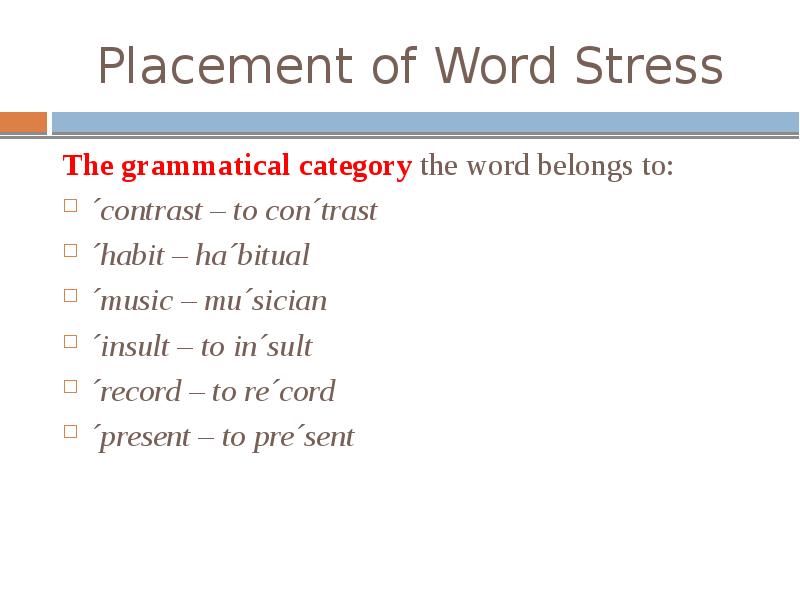
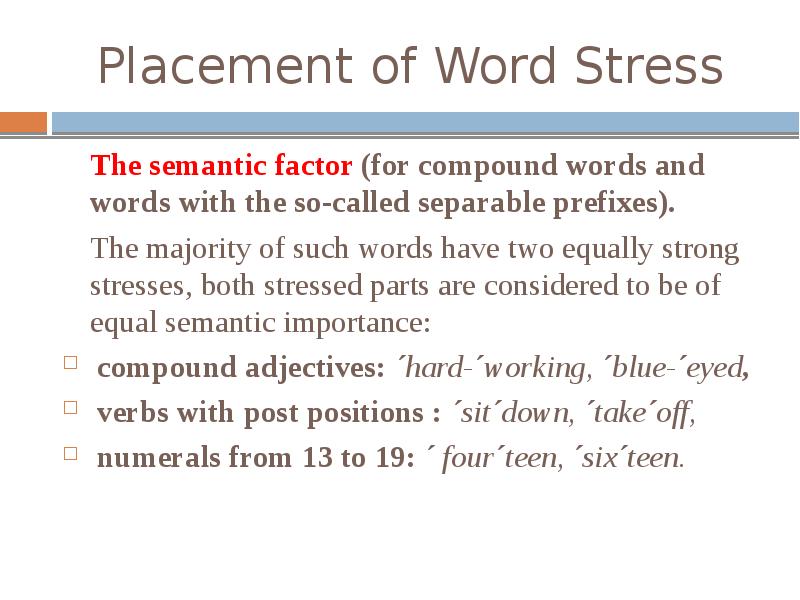
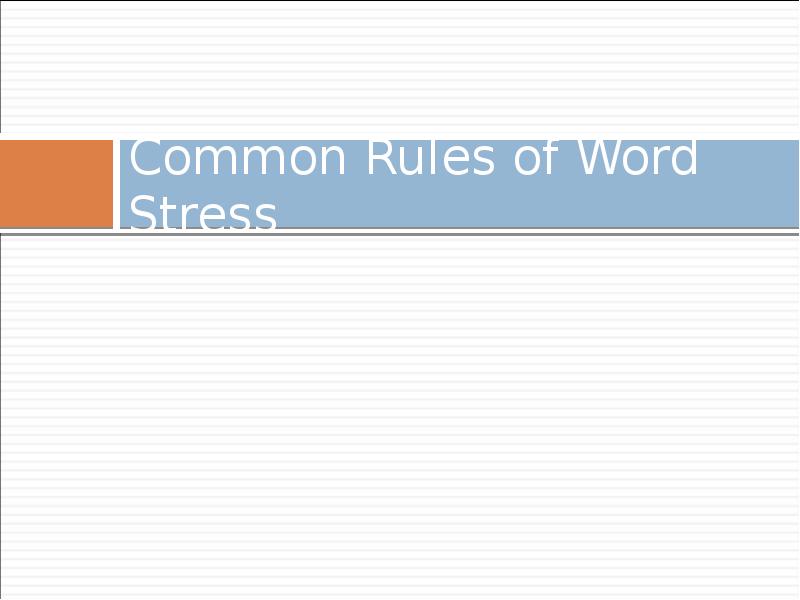

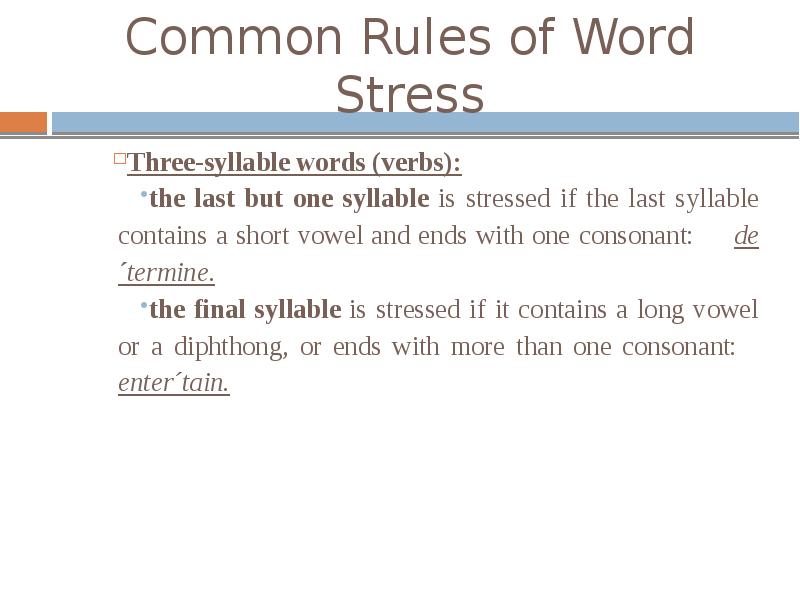

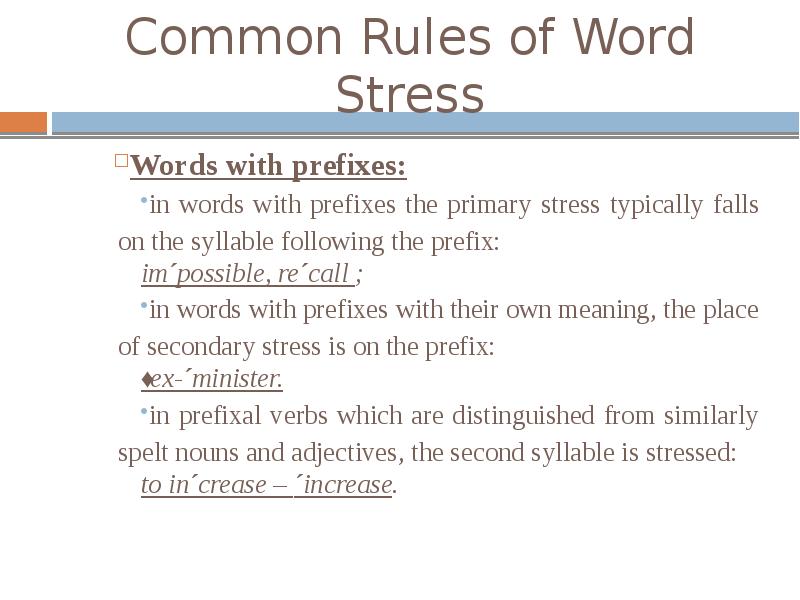
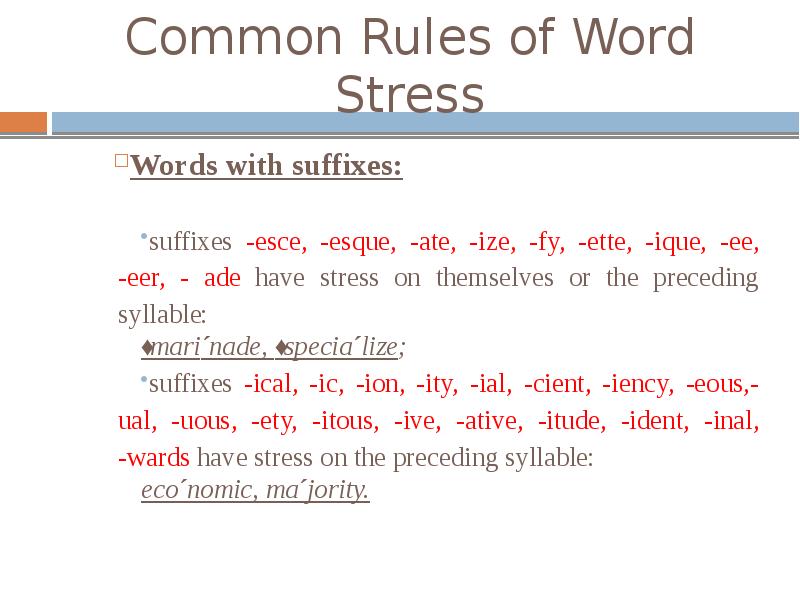
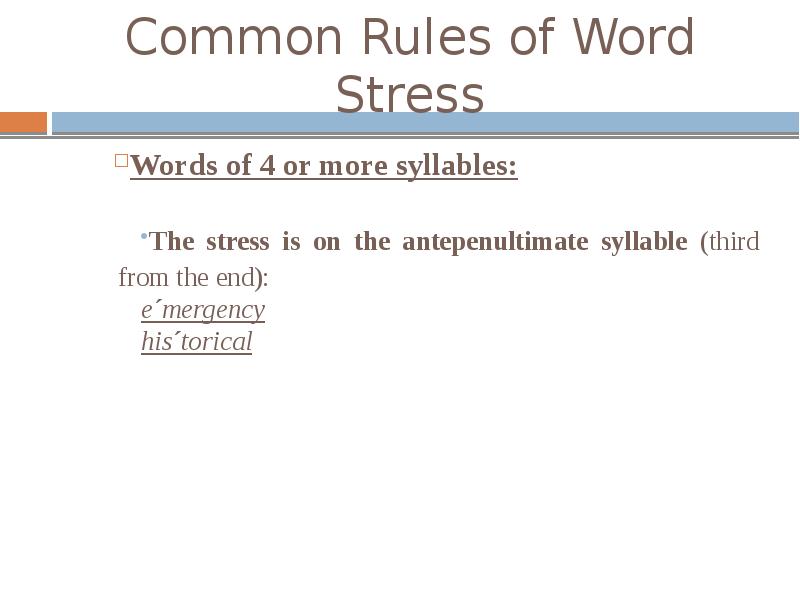
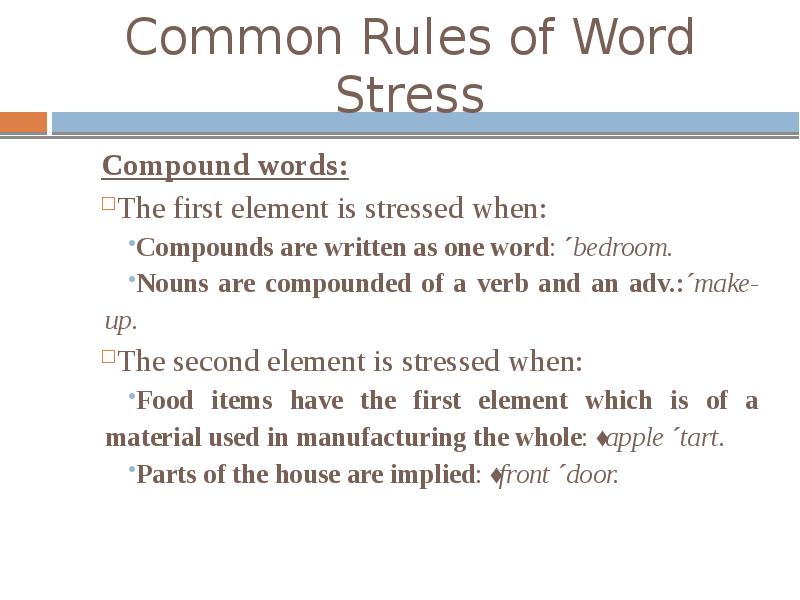
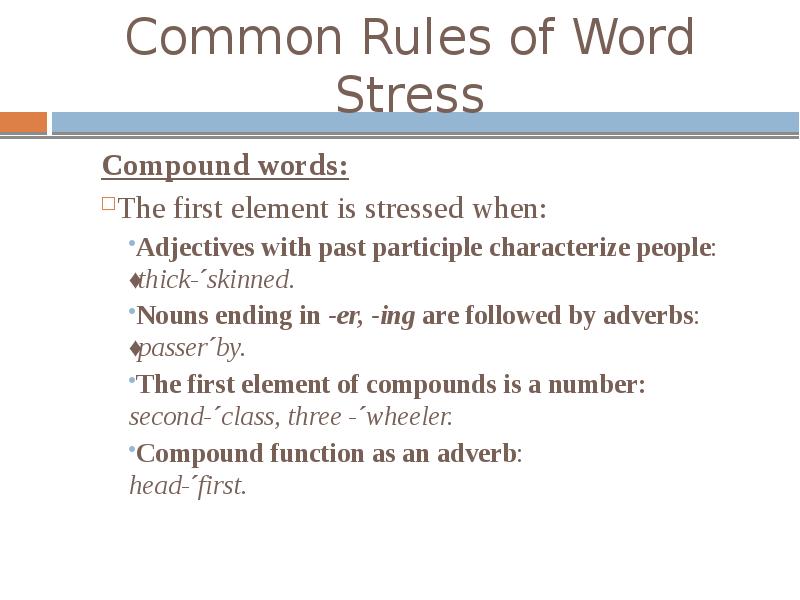
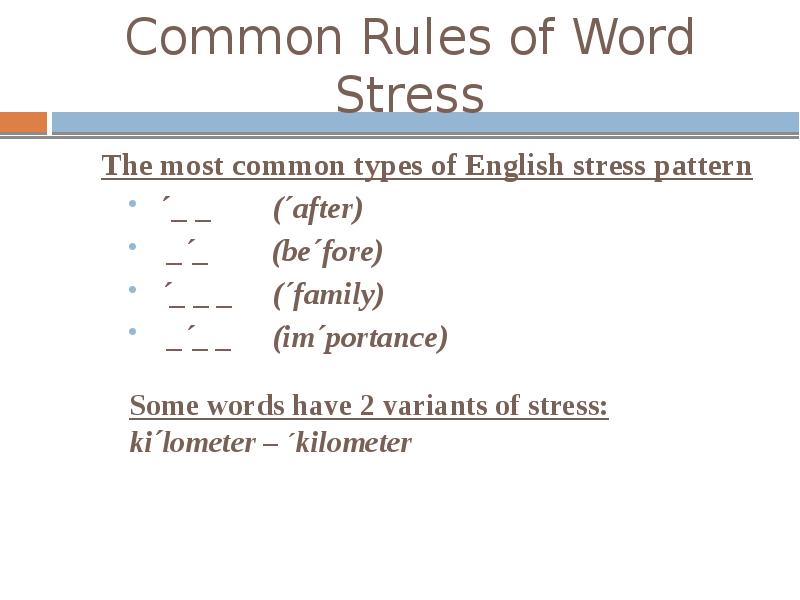

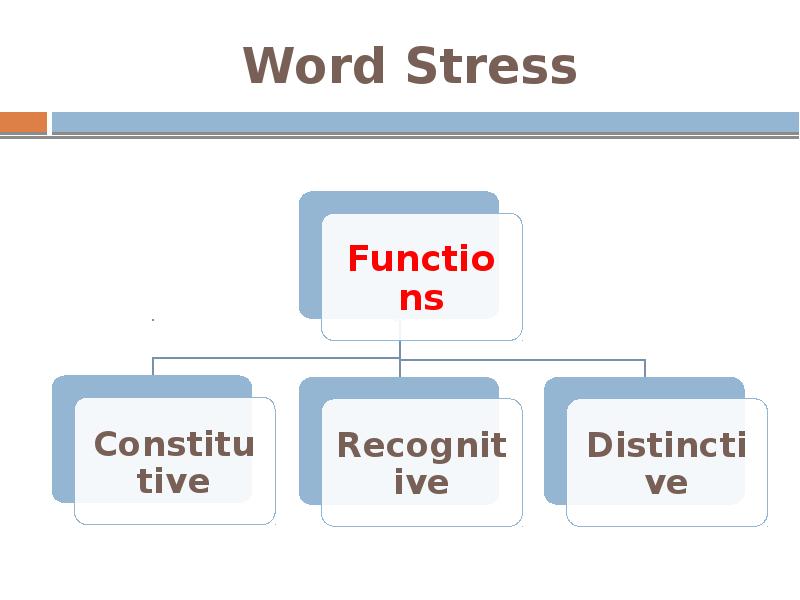
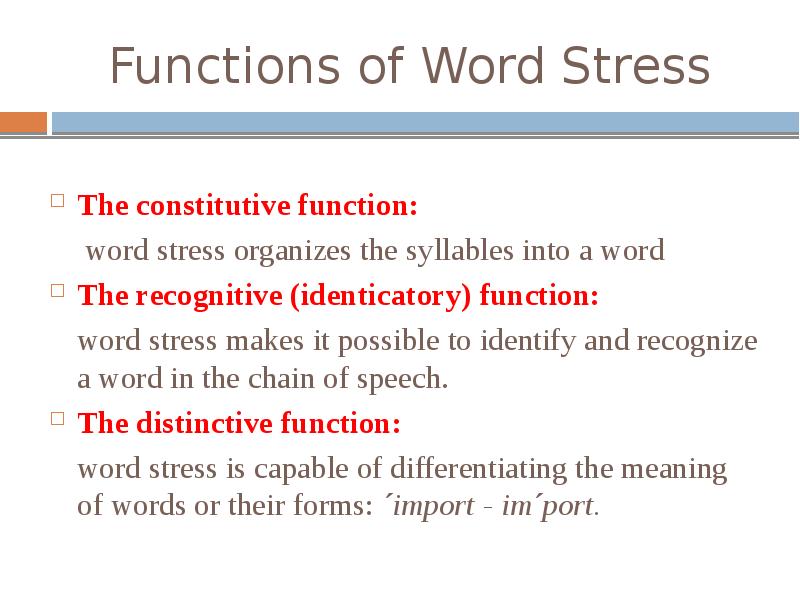
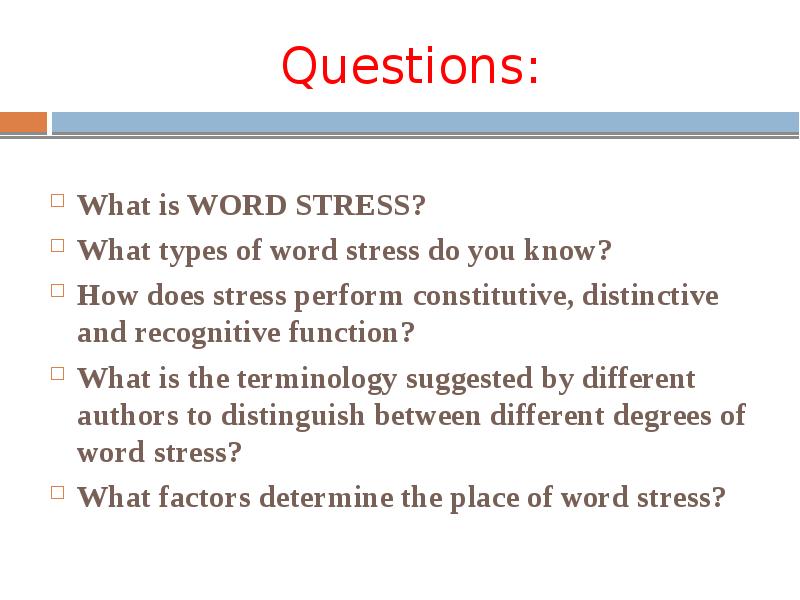
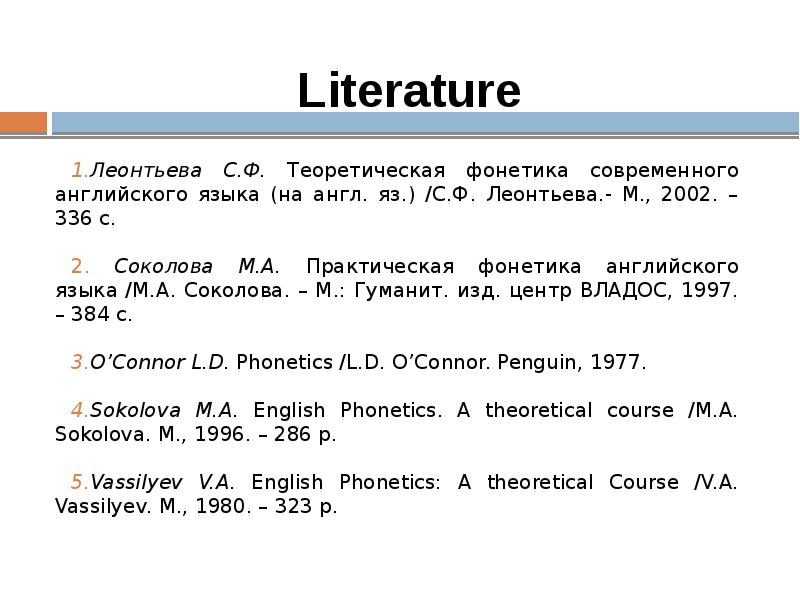























![2. [ '_ '_ ]. The accentual type is commonly realized in compound words, mo... 2. [ '_ '_ ]. The accentual type is commonly realized in compound words, mo...](https://documents.infourok.ru/939f8786-d5c0-4ba5-82df-a9c1fc738db2/slide_24.jpg)
![4. [ˌ _'___]. The accentual type marks a great number of simple words and s... 4. [ˌ _'___]. The accentual type marks a great number of simple words and s...](https://documents.infourok.ru/939f8786-d5c0-4ba5-82df-a9c1fc738db2/slide_25.jpg)
